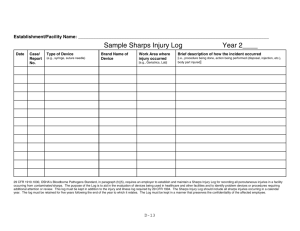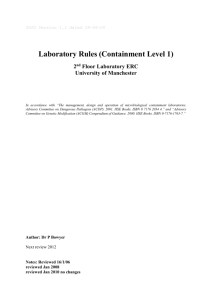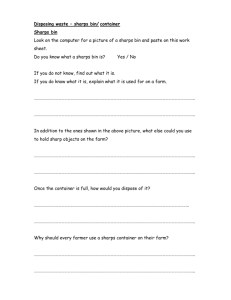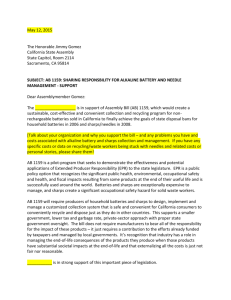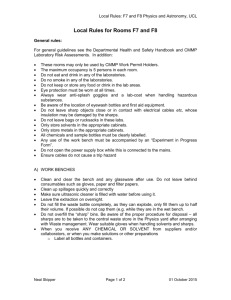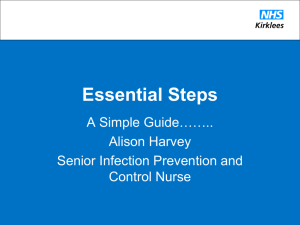BD ecoFinity® Life Cycle Solution Environmental
advertisement
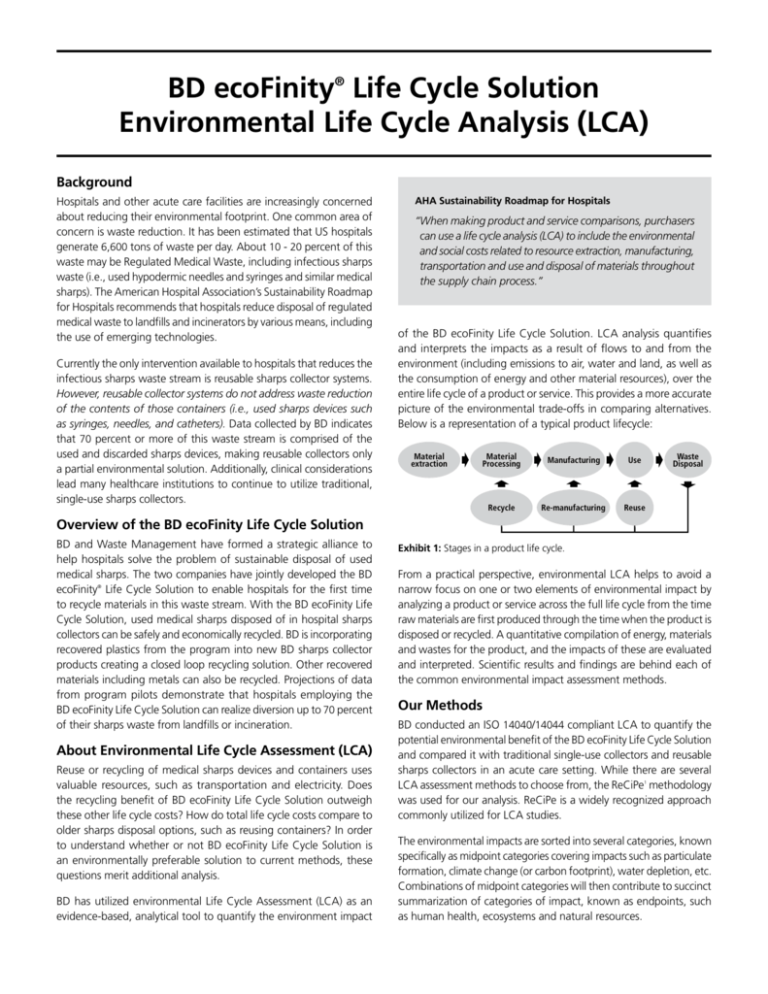
BD ecoFinity® Life Cycle Solution Environmental Life Cycle Analysis (LCA) Background Hospitals and other acute care facilities are increasingly concerned about reducing their environmental footprint. One common area of concern is waste reduction. It has been estimated that US hospitals generate 6,600 tons of waste per day. About 10 - 20 percent of this waste may be Regulated Medical Waste, including infectious sharps waste (i.e., used hypodermic needles and syringes and similar medical sharps). The American Hospital Association’s Sustainability Roadmap for Hospitals recommends that hospitals reduce disposal of regulated medical waste to landfills and incinerators by various means, including the use of emerging technologies. Currently the only intervention available to hospitals that reduces the infectious sharps waste stream is reusable sharps collector systems. However, reusable collector systems do not address waste reduction of the contents of those containers (i.e., used sharps devices such as syringes, needles, and catheters). Data collected by BD indicates that 70 percent or more of this waste stream is comprised of the used and discarded sharps devices, making reusable collectors only a partial environmental solution. Additionally, clinical considerations lead many healthcare institutions to continue to utilize traditional, single-use sharps collectors. AHA Sustainability Roadmap for Hospitals “When making product and service comparisons, purchasers can use a life cycle analysis (LCA) to include the environmental and social costs related to resource extraction, manufacturing, transportation and use and disposal of materials throughout the supply chain process.” of the BD ecoFinity Life Cycle Solution. LCA analysis quantifies and interprets the impacts as a result of flows to and from the environment (including emissions to air, water and land, as well as the consumption of energy and other material resources), over the entire life cycle of a product or service. This provides a more accurate picture of the environmental trade-offs in comparing alternatives. Below is a representation of a typical product lifecycle: Material extraction Material Processing Manufacturing Use Recycle Re-manufacturing Reuse Waste Disposal Overview of the BD ecoFinity Life Cycle Solution BD and Waste Management have formed a strategic alliance to help hospitals solve the problem of sustainable disposal of used medical sharps. The two companies have jointly developed the BD ecoFinity® Life Cycle Solution to enable hospitals for the first time to recycle materials in this waste stream. With the BD ecoFinity Life Cycle Solution, used medical sharps disposed of in hospital sharps collectors can be safely and economically recycled. BD is incorporating recovered plastics from the program into new BD sharps collector products creating a closed loop recycling solution. Other recovered materials including metals can also be recycled. Projections of data from program pilots demonstrate that hospitals employing the BD ecoFinity Life Cycle Solution can realize diversion up to 70 percent of their sharps waste from landfills or incineration. About Environmental Life Cycle Assessment (LCA) Reuse or recycling of medical sharps devices and containers uses valuable resources, such as transportation and electricity. Does the recycling benefit of BD ecoFinity Life Cycle Solution outweigh these other life cycle costs? How do total life cycle costs compare to older sharps disposal options, such as reusing containers? In order to understand whether or not BD ecoFinity Life Cycle Solution is an environmentally preferable solution to current methods, these questions merit additional analysis. BD has utilized environmental Life Cycle Assessment (LCA) as an evidence-based, analytical tool to quantify the environment impact Exhibit 1: Stages in a product life cycle. From a practical perspective, environmental LCA helps to avoid a narrow focus on one or two elements of environmental impact by analyzing a product or service across the full life cycle from the time raw materials are first produced through the time when the product is disposed or recycled. A quantitative compilation of energy, materials and wastes for the product, and the impacts of these are evaluated and interpreted. Scientific results and findings are behind each of the common environmental impact assessment methods. Our Methods BD conducted an ISO 14040/14044 compliant LCA to quantify the potential environmental benefit of the BD ecoFinity Life Cycle Solution and compared it with traditional single-use collectors and reusable sharps collectors in an acute care setting. While there are several LCA assessment methods to choose from, the ReCiPe1 methodology was used for our analysis. ReCiPe is a widely recognized approach commonly utilized for LCA studies. The environmental impacts are sorted into several categories, known specifically as midpoint categories covering impacts such as particulate formation, climate change (or carbon footprint), water depletion, etc. Combinations of midpoint categories will then contribute to succinct summarization of categories of impact, known as endpoints, such as human health, ecosystems and natural resources. The process map below describes the differences in each sharps disposal system. Sharps Waste Collector Sharps Waste & Collector Standard Sharps Disposal Standard Sharps Disposal Wash Sanitization Separation Reuse Plastic Metal Others Recycle Recycle Disposal Exhibit 2: Single-use sharps collector, typical reusable collector system and BD ecoFinity Life Cycle Solution. Major Assumptions and System Boundaries Single-Use Collectors: Manufactured with 20 percent recycled resin, shipped in a nested configuration in corrugated cases. Reusable Collectors: Manufactured with virgin materials, shipped assembled without extra packaging, contained in transport carts for relocation to off-site regional washing and waste processing centers, collectors washed with water rates comparable to commercial dishwashing systems, reused an average of 200 times each. BD ecoFinity Life Cycle Solution: Utilized BD single-use collectors manufactured with 20 percent recycled resin, achieving minimum 65 percent material diversion to plastics and metal recycling with the collector and contents.** Standard Sharps Disposal: Waste disposition of sharps waste is 35 percent incineration, and 65 percent autoclave, grinding and landfill. Waste/Collector Volume: average 4.1 lbs per 3 gallon collector. **Resource consumption of processes, such as water use and electricity use, were based on the pilot program running in 2010 and early 2011. The comparison was based on the functional unit, which was defined as the collection and safe disposal of 10,000 lbs of sharps waste. The amount of sharps waste can be scaled up to 100,000 lbs, which is interpreted as the amount of sharps waste generated by a 500-bed hospital over one year. The size of the collectors studied for all three systems is 3 gallons, utilized for sharps waste only. Results In the LCA, raw data is used to calculate midpoint categories, which are in turn used to calculate endpoint categories. Below is the complete reporting for endpoint categories and midpoint categories, followed by an example of a raw data that was collected. Endpoint Categories The ReCiPe method reports human health, ecosystem health, and natural resources endpoints as key environmental indicators. These are the accepted and only endpoint categories reported for the ReCiPe method. The results of the comparative analysis indicate that for the collection and disposal of 100,000 lbs of sharps waste, use of the BD ecoFinity Life Cycle Solution is environmentally preferable and results in the lowest life cycle environmental impacts in all three categories relative to the other two sharps collection systems. BD ecoFinity -4 666,000 10x10 0.19 -4 9x10 80% Impact Sharps Waste & Collector Reusable 0.20 100% BD EcoFinity Life Cycle Solution Environmental Reusable Collectors Single-Use 400,000 60% 0.09 -4 5x10 40% 20% -170,000 0% Benefit Single-Use Collectors Results per 100,000 lbs of Disposed Sharps Waste DALY -20% Human Health Species/Yr. $ Ecosystems Resources Endpoint Categories -40% Exhibit 3: Comparison of the life cycle impacts of Single-Use, Reusable and BD ecoFinity sharps collection system for the handling of sharps waste scaled to a 500-bed hospital for one year. The endpoint categories are created from a series of data points called midpoint categories. The accepted midpoint categories for the ReCiPe method include climate change, ozone depletion, human toxicity, photochemical oxidant formation, water depletion, fossil depletion and ecosystems. The results of the comparative analysis are shown below. Midpoint categories Reusable Single-Use 119,000 kg CO2 eq. BD ecoFinity 114,000 kg CO2 eq. 100% 80% 60% 48,000 kg CO2 eq. 40% 20% 0% -20% -40% Climate Change Ozone Depletion Human Toxicity Photochem. Oxidant Form. Water Depletion Fossil Depletion Ecosystems (Damage) Exhibit 4: Comparison of the life cycle impacts of Single-Use, Reusable and BD ecoFinity sharps collection systems for the handling of sharps waste scaled to a 500-bed hospital for one year. When compared to the reusable system, the BD ecoFinity Life Cycle Solution has the lowest relative impacts for six of the seven environmental indicators considered, with reductions in impacts of more than 50 percent in five of those six categories. One category of note was climate change. Results show reductions in greenhouse gas emissions of nearly 60 percent. One current tradeoff for the BD ecoFinity Life Cycle Solution is water depletion. The sanitization process utilized to process the waste prior to recycling uses water and resulted in higher water depletion relative to the other sharps collection systems. BD and WM are currently exploring other sanitization processes that have lower water demand in an effort to address this issue for further improvement. To understand the magnitude of carbon footprint change associated with the BD ecoFinity program, there is a forecasted carbon footprint savings of 288 million lbs of CO22 equivalent if all hospitals in the US were to implement the BD ecoFinity3 Life Cycle Solution. This is equivalent to the amount of green house gas absorbed by 6 million trees per year.4 Results per 100,000 lbs of Disposal Sharps Waste Single-Use Reusable 80% Raw Data The total amount of waste sent to landfill or incineration includes the collected sharps waste plus the collectors used. The results of the life cycle inventory utilizing the data from the pilot runs indicate a diversion of 65 percent of the solid waste stream from their sharps collection activities (Exhibit 5). Other projections, scaling to operational efficiencies associated with full-sized production lots, show a higher diversion rate. For the competitive reusable system, only 28 percent of the solid waste stream gets diverted from landfill. For every 100,000 lbs of sharps waste collected, the total solid waste stream sent to disposal from the BD ecoFinity system was just 49,512 lbs, compared to 100,543 lbs for the competitive reusable system, which includes 100,000 lbs of sharps waste and 543 lbs of collectors that have reached end of life. Reusable Total waste amount 75% 50% 140,000 41,463 lbs collector waste 543 lbs collector waste 100,000 lbs sharps waste 100,000 lbs sharps waste 25% 0% 120,000 100,000 80,000 60,000 49,512 lbs sharps waste 40,000 20,000 60% 200 reuses 200 reuses 500 reuses 500 reuses 200 reuses 200 reuses 500 reuses 500 reuses 40% 20% 0% Human Health Ecosystems Resources Climate Change DALY Species/Yr. $ CO2 eq. -20% -40% BD ecoFinity Total waste amount (lbs) Single-Use 100% BD ecoFinity 100% 0 Exhibit 5: Amount of sharps waste sent to final disposal per 100,000 lbs sharps waste collected for Single-Use, Reusable and BD ecoFinity sharps collection systems. Exhibit 6: Comparison of 500 reuses versus 200 reuses for reusable collectors. Single-Use 100% Reusable 10 reuses BD ecoFinity 10 reuses 10 reuses 10 reuses 80% 200 reuses 200 reuses 200 reuses 60% 200 reuses Sensitivity Analysis Number of times a reusable container is reused There are varying reports on how many times the typical reusable collector can be reused before they reach the end of their service life. Estimates range from <10 to 500. An assumption of 200 reuses was used for the LCA model. The sensitivity of the study results to this assumption has been tested by also generating results based on an assumption of 500 reuses (Exhibit 6) for the reusable system, and an assumption of 10 reuses (Exhibit 7). Results of the sensitivity test using an assumption of 500 reuses indicate that although the reusable system’s contribution to each impact category is slightly lower, the overall comparative results do not change and the BD ecoFinity Life Cycle Solution still results in the lowest impacts in every category with the exception of water depletion. Results of the sensitivity test using an assumption of 10 reuses indicate that the reusable system’s contribution to each impact category is higher than with 200 reuses. Overall the results of the sensitivity test for reusable collector service life indicate that the results for the reusable system are sensitive to the assumed number of reuses; however, even under the best-case scenario for the reusable system, the BD ecoFinity Life Cycle Solution still results in lower environmental impacts in all endpoint categories. This suggests that the assumption of 200 reuses is reasonable. 40% 20% 0% -20% Human Health Ecosystems Resources Climate Change DALY Species/Yr. $ CO2 eq. -40% Exhibit 7: Comparison of 10 reuses versus 200 reuses for reusable collectors. Conclusions/Discussion These results indicate that the BD ecoFinity Life Cycle Solution is an environmentally preferable sharps disposal approach in the acute care setting compared to older sharps disposal methods. Why is this? The key reason for the superior environmental performance of the BD ecoFinity Life Cycle Solution is the reclamation and recycling of used medical sharps devices (syringes, catheters, etc.) that traditionally are disposed of via landfill or incineration. The recycling of this waste stream diverts significant amounts of solid waste and reduces the amount of raw materials required to produce new collectors. Sensitivity analysis regarding key assumptions for BD ecoFinity and reusable collector systems does not change the conclusions of this study. Additionally, with this analysis, key focal points of environmental impact (such as water usage) for BD ecoFinity have been identified and are being addressed to further improve environmental performance. We believe that this level of scientific scrutiny can be a valuable tool for OEMs that seek to reduce the environmental footprint of healthcare facilities. Summary For acute care facilities seeking to reduce their environmental footprint, the BD ecoFinity Life Cycle Solution is the environmentally preferable disposal solution for single-use medical sharps, such as hypodermic needles and syringes. By implementing BD ecoFinity, hospitals can continue to realize the clinical advantages of BD’s best-in-class single-use medical devices, while reducing the environmental impact of medication delivery. Independent Review The information contained within this paper was not subject to third-party review. An ISO 14044 compliant life cycle analysis was conducted by BD and EarthShift LLC. The study design, major assumptions and final results and analyses were subject to independent, third party review by recognized experts in the field of LCA. The full study can be obtained by contacting BD at: https://forms.bd.com/mscu/index.sp. oedkoop M., Heijungs R., Huijbregts M., Schryver A.D., Struijs J., Van Zelm R. (2009). ReCiPe 2008, First edition. Pre Consultants, Amersfoort, Netherlands, CML, G University of Leiden, Netherlands, RUN Radbound University Nijmegen Netherlands, RIVM, Bilthoven, Netherlands. In 2010, there were 944,277 hospital beds in the US. http://www.aha.org/aha/resource-center/Statistics-and-Studies/fast-facts.html. 3 Assume currently 70% of the beds utilize disposable collectors, and 30% of the hospital beds are using reusable collectors. 4 McAliney, Mike. Arguments for Land Conservation: Documentation and Information Sources for Land Resources Protection, Trust for Public Land, Sacramento, CA, December, 1993. 5 FAQ of the Daniels website: http://danielsinternational.com/about-us/faqs-0. 6 FAQ of the Daniels website: http://danielsinternational.com/about-us/faqs-0. 7 The review panel assessed the LCA as independent entities. Their opinions do not represent the opinion of their respective organizations. 1 2 BD, BD Logo and BD ecoFinity are trademarks of Becton, Dickinson and Company. WM Waste Management logo and THINK GREEN. are registered service marks of Waste Management, Inc. Collection and treatment services are provided by WM Healthcare Solutions, Inc., a Waste Management company, except in the state of New York, where services are provided by Waste Management of New York, L.L.C. New York BIC# 01146. © 2011 BD and WM Healthcare Solutions, Inc. 10/11 0853
